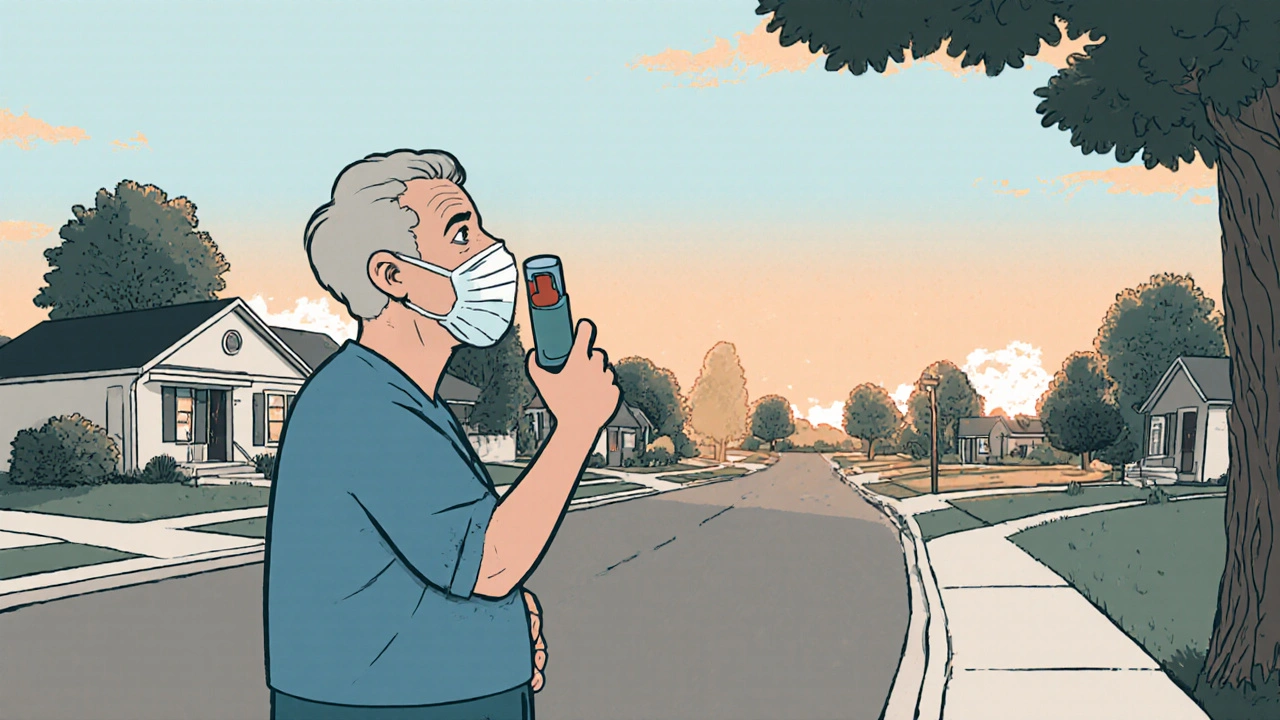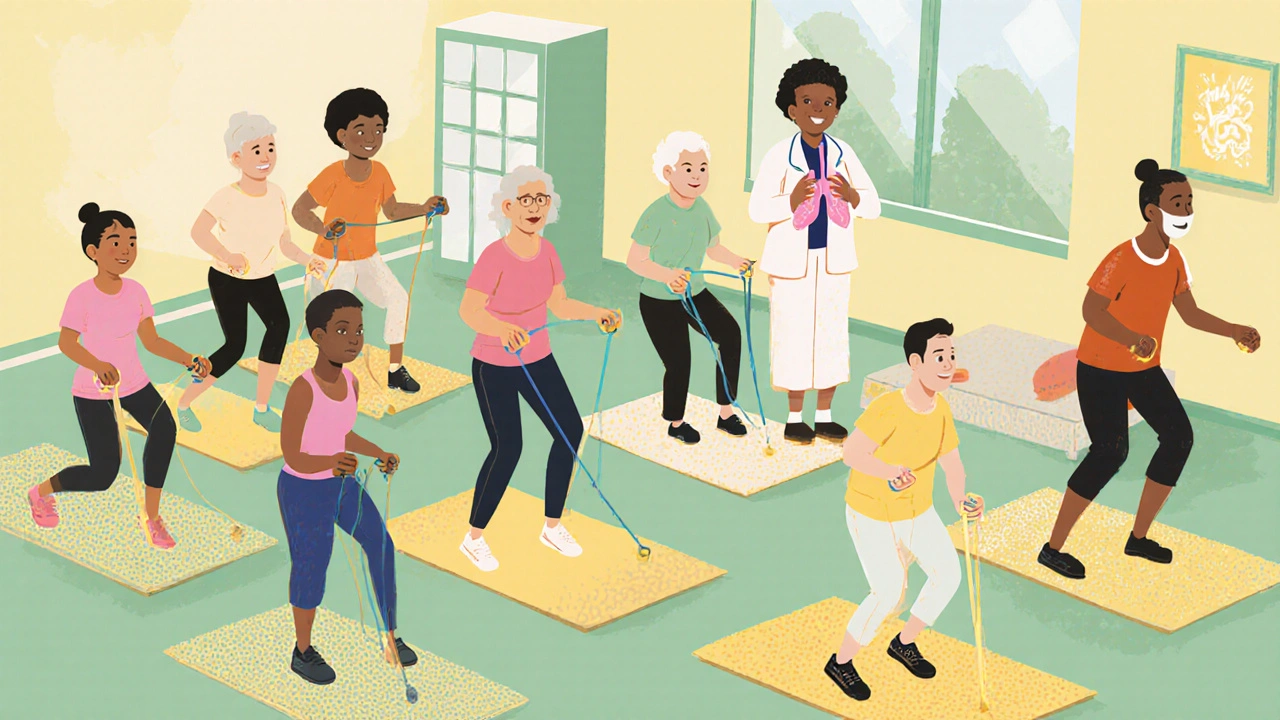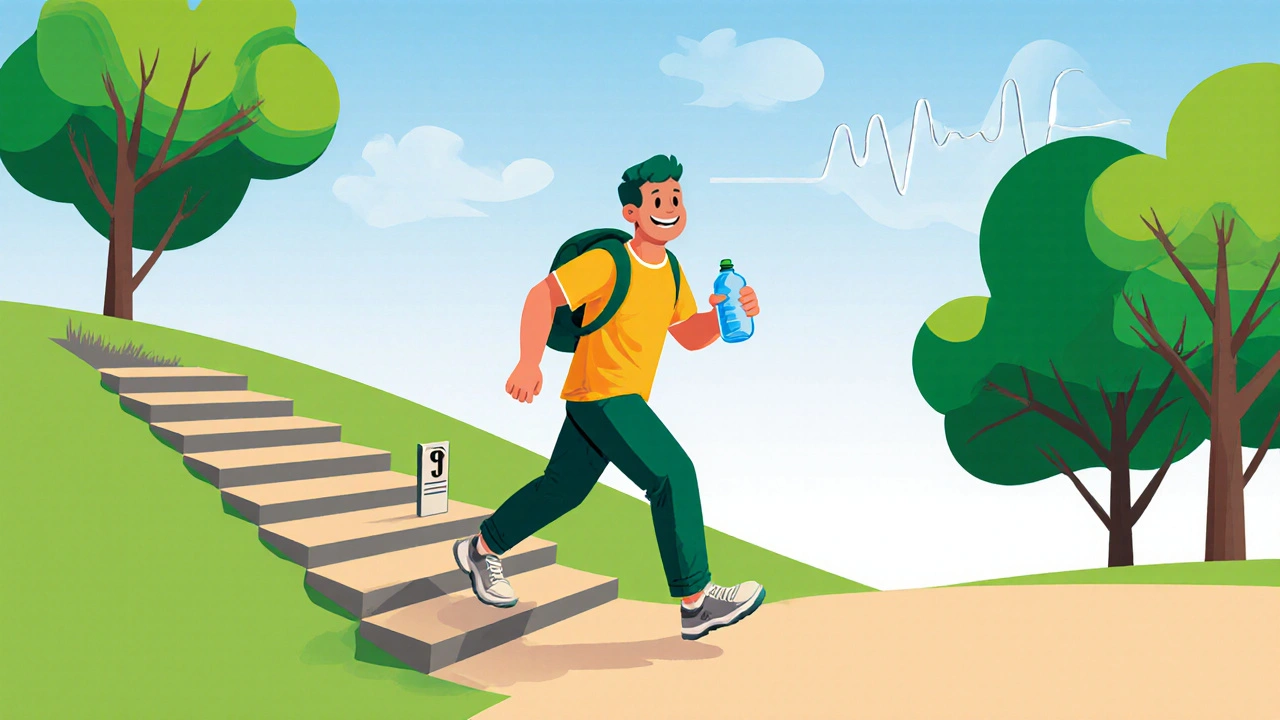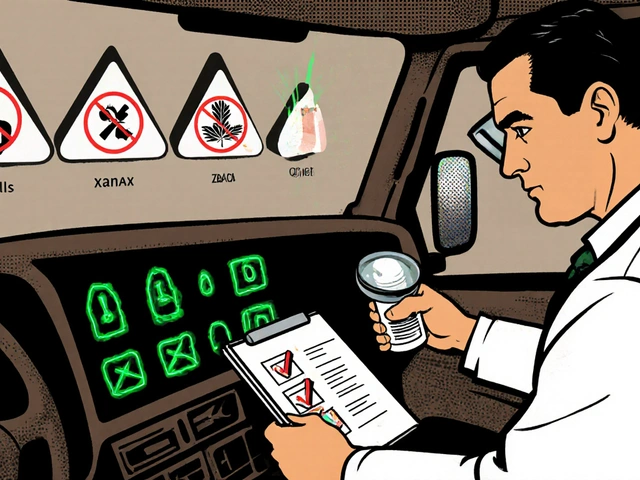
COPD Exercise Intensity Calculator
Find Your Safe Exercise Zone
Based on your current breathlessness level (1-10 scale)
Progression Tip
When ready to increase intensity, follow the 10% Rule: Never increase duration or intensity by more than 10% per week.
Living with Chronic Obstructive Pulmonary Disease (COPD) is a daily battle against breathlessness, fatigue, and the fear of worsening symptoms. While medication and inhalers are essential, many people overlook a simple, low‑cost tool that can make a huge difference: regular physical activity. In this guide we’ll explore why exercise matters for COPD, what types of movement work best, and how to start safely, even if you’re short of breath right now.
Key Takeaways
- Exercise improves lung function, reduces breathlessness, and boosts overall quality of life for people with COPD.
- Both aerobic and strength training are beneficial; start with low‑impact activities and progress gradually.
- Pulmonary rehabilitation programs provide supervised, personalized exercise plans and education.
- Monitoring tools like spirometry and symptom diaries help you track progress and adjust intensity.
- Safety tips - warm‑up, proper inhaler use, and pacing - keep you exercising without triggering flare‑ups.
Understanding COPD and Its Impact on Activity
Chronic Obstructive Pulmonary Disease (often shortened to COPD) is a progressive condition that narrows the airways and reduces lung elasticity. The hallmark symptoms are chronic cough, excess mucus, and dyspnea (shortness of breath). As the disease advances, everyday tasks like climbing stairs or carrying groceries can feel exhausting.
Why does activity become harder? In COPD the airway obstruction forces the respiratory muscles to work overtime, which quickly leads to fatigue. Over time, people often avoid exercise, causing a vicious cycle of deconditioning-muscles become weaker, the heart works harder, and breathlessness worsens.
Why Exercise Makes a Difference
Regular movement breaks that cycle in several concrete ways:
- Improves muscle efficiency. Aerobic training teaches the body to use oxygen more effectively, so the lungs don’t have to work as hard for the same activity.
- Reduces inflammation. Studies from the World Health Organization show that moderate exercise lowers systemic inflammatory markers, which can slow COPD progression.
- Strengthens respiratory muscles. Targeted breathing exercises and resistance training make the diaphragm and intercostal muscles less prone to fatigue.
- Enhances mood and confidence. Endorphin release and a sense of achievement lower anxiety about breathlessness.
All of these benefits translate into fewer hospital admissions, better response to medication, and a higher ability to perform daily chores.
Types of Exercise That Help COPD
Not every workout is created equal for COPD patients. Below is a quick rundown of the most effective categories.
| Exercise Type | Frequency | Key Benefits | Example Activity |
|---|---|---|---|
| Aerobic (low‑impact) | 3-5 times/week | Improves cardiovascular endurance, reduces dyspnea | Brisk walking, stationary cycling, water aerobics |
| Strength Training | 2-3 times/week | Builds limb and respiratory muscle strength | Resistance bands, light dumbbells, body‑weight squats |
| Breathing Exercises | Daily | Enhances diaphragm control, lowers breathing rate | Pursed‑lip breathing, diaphragmatic breathing |
| Flexibility & Balance | 2-3 times/week | Reduces fall risk, improves posture | Gentle yoga, tai chi |
Start with the aerobic option that feels most comfortable-usually a 10‑minute walk around the neighbourhood. Gradually increase the duration by five minutes each week until you hit 30 minutes per session.

Safety First: Tips to Exercise Without Tripping Up
Before you lace up the shoes, keep these pointers in mind:
- Get a medical clearance. A clinician can assess your baseline using spirometry and decide whether supplemental oxygen therapy is needed during activity.
- Warm up and cool down. Five minutes of gentle marching or arm circles prepares the lungs and heart.
- Use inhalers correctly. A short‑acting bronchodilator taken 15 minutes before exercise opens the airways and reduces wheezing.
- Monitor symptoms. Stop if you experience chest pain, severe dizziness, or a sudden spike in coughing.
- Stay hydrated. Fluids thin mucus, making it easier to clear.
Building a Personal Exercise Routine
Here’s a simple 4‑week starter plan. Adjust the minutes based on what you can comfortably do, but try to stay consistent.
- Week 1: Walk 10 minutes at a leisurely pace, 3 days; perform 5 minutes of diaphragmatic breathing daily.
- Week 2: Increase walking to 15 minutes, add 2 days of light resistance band exercises (10 reps, 2 sets).
- Week 3: Walk 20 minutes, introduce a 5‑minute cool‑down stretch; continue breathing exercises.
- Week 4: Walk 30 minutes, add a second strength‑training day, and try a gentle yoga session for flexibility.
Log each session in a notebook or app. Note the perceived breathlessness on a scale of 1-10; this helps you spot trends and discuss progress with your doctor.
Role of Pulmonary Rehabilitation Programs
Many hospitals and community centers run pulmonary rehabilitation programs specifically for COPD. These multidisciplinary services combine supervised exercise, education on inhaler technique, nutrition counseling, and psychosocial support.
Benefits of joining a program include:
- Personalized exercise prescription based on fitness testing.
- Immediate feedback from respiratory therapists, reducing the risk of overexertion.
- Peer motivation - seeing others manage similar challenges can boost confidence.
- Access to the latest guidelines from entities like the World Health Organization and national lung health bodies.
If you can’t travel to a center, many providers now offer virtual rehab sessions, where a therapist monitors you via video and guides you through the same routine.

Tracking Progress and Adjusting the Plan
Objective measurements keep you motivated and inform clinicians whether the current regimen is effective. Common tools:
- Spirometry. A repeat test after 6-12 weeks can show improvements in FEV1 (forced expiratory volume) or at least a slower decline.
- 6‑Minute Walk Test (6MWT). Measures how far you can walk in six minutes; gains of 30‑50 meters are clinically meaningful.
- Symptom Diary. Record shortness of breath, cough, and medication usage each day.
When you notice reduced dyspnea scores or longer walking distances, consider upping the intensity slightly - perhaps by adding a hill segment or a few extra resistance bands reps.
Common Pitfalls and How to Avoid Them
Even with the best plan, missteps happen. Here are the usual culprits and quick fixes:
- Skipping warm‑up. Leads to premature breathlessness. Set a timer for a five‑minute warm‑up each session.
- Doing too much, too fast. Increases risk of flare‑ups. Follow the “10% rule” - raise duration or intensity by no more than 10% each week.
- Ignoring medication timing. Forgetting the pre‑exercise bronchodilator reduces airway opening. Keep a pill box labeled “Exercise” as a reminder.
- Not tracking progress. Without data you can’t see gains, which may cause discouragement. Use a simple spreadsheet or a phone note.
Putting It All Together
Exercise isn’t a cure for COPD, but it’s a powerful ally. By choosing low‑impact aerobic activities, adding strength work, and staying mindful of symptom cues, you can reclaim stamina and enjoy daily life more fully. Partner with your healthcare team, consider a pulmonary rehabilitation program, and monitor your progress with tools like spirometry and walking tests. The effort you put in now pays off with fewer hospital visits, better mood, and a stronger, more resilient body.
Frequently Asked Questions
Can I start exercising if I’m currently experiencing a COPD flare‑up?
During an acute exacerbation you should focus on rest and follow your doctor’s medication plan. Light breathing exercises may be okay, but hold off on aerobic or strength work until symptoms stabilize.
Do I need special equipment for a home exercise routine?
No fancy gear is required. A sturdy chair, a set of resistance bands, and a pair of comfortable shoes are enough to start. If you have space, a stationary bike works well for low‑impact cardio.
How often should I use my rescue inhaler during exercise?
Take a short‑acting bronchodilator 15 minutes before starting. If you feel sudden wheezing or a sharp increase in breathlessness during the session, use it again as prescribed, then pause the activity.
Is it safe to exercise in cold weather with COPD?
Cold air can trigger bronchoconstriction. If you must exercise outdoors, wear a scarf over your mouth and nose, keep the intensity moderate, and consider indoor alternatives on very chilly days.
What improvements should I look for to know my exercise plan works?
Noticeable signs include less breathlessness during daily chores, longer distances on the 6‑Minute Walk Test, and lower scores on the Borg dyspnea scale. Regular spirometry showing a slower decline in FEV1 also signals benefit.




Sara Werb
October 17, 2025 AT 18:14I’m telling you, the whole “exercise will cure COPD” hype is just another way for big pharma to sell more prescripton!!! They don’t want you walking in the park, they want you glued to the inhaler bottle!!! Wake up, folks!!!
Winston Bar
October 23, 2025 AT 08:46Sure, walk a few blocks and magically your lungs will be fine. I’ve seen nothing but hype and wasted effort.
Russell Abelido
October 28, 2025 AT 22:18Man, I get where you’re coming from – the struggle is real, and every breath feels like a tiny victory. Still, think of exercise as a gentle ally, not a miracle cure; even a short walk can coax the diaphragm into remembering its rhythm. 🌟 It’s a slow dance with your body, not a sprint to the finish line, and that’s okay.
Steve Holmes
November 3, 2025 AT 12:50Totally agree, the key is consistency, not intensity, and building a routine that feels doable, especially on tough days, and remembering to warm up, because the lungs need that gentle cue as much as the muscles do.
Tom Green
November 9, 2025 AT 03:21Hey everyone, just chime in – start simple, track progress, and celebrate every little win. A 5‑minute walk today is a foundation for a 30‑minute stroll tomorrow.
Valerie Vanderghote
November 14, 2025 AT 17:53Listen, I’m not trying to be rude, but let me tell you a story that might sound a bit personal, yet it’s exactly why I care so fiercely about this topic. A few years back I was sitting on my couch, feeling the crushing weight of breathlessness, and I thought, “Why am I even alive if I can’t even climb a single flight of stairs?” Then I decided to push myself – literally – to take a 10‑minute stroll to the mailbox, even though my chest felt like a vice. That tiny step sparked a cascade: my heart rate steadied, my mind cleared, and I realized that my lungs were not just static machines but responsive organs that could adapt, even if slowly. Over weeks I added a few minutes, then a band of resistance exercises, and soon I was able to garden without stopping every few breaths. The point is, when you hear the hype you might think it’s a quick fix, but the reality is a series of tiny, gritty victories that compound. I know you might think I’m over‑sharing, but I’ve watched too many friends give up because they expected a miracle and got nothing. My own journey taught me that the “exercise cure” isn’t a lie; it’s a marathon of perseverance, and every ounce of effort matters. So please, don’t dismiss the guide because it isn’t a silver bullet – embrace the process, and you’ll see the change, inch by inch, breath by breath.
Michael Dalrymple
November 20, 2025 AT 08:25From a coaching perspective, the key is to treat exercise as a structured, progressive program rather than an occasional activity. Begin with low‑impact aerobic work, monitor your perceived exertion, and gradually increase either duration or intensity by no more than ten percent each week. Coupled with proper inhaler timing, this approach minimizes the risk of exacerbations while fostering muscular endurance and respiratory efficiency.
Emily (Emma) Majerus
November 25, 2025 AT 22:56Got it, keep it simple and steady.
Virginia Dominguez Gonzales
December 1, 2025 AT 13:28I hear you, Winston, and I’ll add that every bit of movement can be a lifeline, especially when you feel the world closing in on your chest. Think of it as a gentle rebellion against the disease, a way to claim back control without forcing your body beyond its limits. You deserve the chance to feel a little lighter each day.
Carissa Padilha
December 7, 2025 AT 04:00Honestly, that whole “exercise helps COPD” thing smells like a government‑sponsored distraction; they want you focused on walking while they pull the strings behind the curtains. And don’t even get me started on the hidden agenda to keep pharmaceutical sales high – you’re just a pawn in a larger game. Still, I’m not saying it’s all deceit; maybe there’s a grain of truth, but it’s buried under layers of propaganda.
Richard O'Callaghan
December 12, 2025 AT 17:14Wow, love the take – but honestly, i think too much focus on conspiracies can distract from practical steps. Just try a short walk and see how you feel.